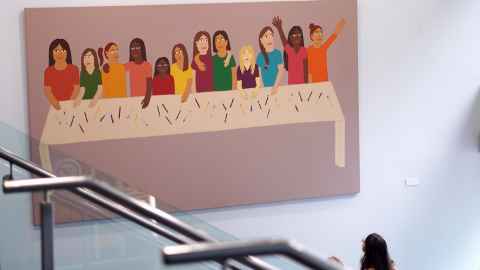Ayesha Green artwork: portrait of an optimistic future
1 November 2023
The main entrance to the University of Auckland's General Library has been an ideal place to showcase large artworks. The latest is by Ayesha Green.

Over the years, several significant artworks from the University Art Collection have adorned the expansive wall in the main entrance to the General Library, one of the liveliest thoroughfares at the City Campus.
The most recent was Dr Fiona Pardington’s unmissable photographic triptych, Portrait of a Life-cast of Matua Tawai, Aotearoa/New Zealand (2010). Recently, a monumental work by contemporary painter Ayesha Green arrived to newly occupy the same foyer space. Untitled (2021) is one of the most recent acquisitions to the Art Collection and, measuring 1.9m x 3.3m, has become one of the largest canvas paintings in the University’s care.
Ayesha Green (Ngāti Kahungunu, Kai Tahu) is a contemporary Māori artist. Born in 1987 in Ōtautahi Christchurch, she has spent time further south in Ōtepoti Dunedin and now lives and works in Tāmaki Makaurau Auckland. Following studies at Wintec in Hamilton, Ayesha completed a Master of Fine Arts at Elam School of Fine Arts (2013) and a Graduate Diploma of Arts in Museums and Cultural Heritage from the University (2016).
Working in painting, drawing and sculpture, Ayesha is best known for her distinctive painterly style through which she produces figurative portraits and scenes using flattened blocks of colour and bold outlines. Her subjects are localised and she frequently examines histories of Māori and Pākehā representation by drawing on personal as well as historic references specific to Aotearoa New Zealand.
Untitled (2021) was part of a body of work produced for Ayesha’s solo exhibition, Ayesha Green: To the Best of My Knowledge at Hastings City Art Gallery in 2021. The exhibition interrogated the visual language and history of native schooling in New Zealand, particularly focusing on Hukarere Girls’ College, founded in 1875 in Hawke’s Bay.
As outlined in the accompanying exhibition text, “The early education of Māori girls was pivotal in the assimilation tactics undertaken by the colonial government, alongside missionaries’ activities. As agents of change, Māori girls were expected to take their new-found Pākehā knowledge into the kāinga. However, these women became leaders in advocating for and creating positive change for Māori, whose achievements have given agency to Māori women across the country.”

In Untitled (2021) in particular, Ayesha took inspiration from a well-known and respected Māori woman who was first enrolled at Whakarewarewa Native School in Rotorua in 1903, then came to Hukarere in 1910 to finish her schooling. Rangitīaria Dennan, better known as Guide Rangi, was an advocate for the rights of Māori to self-determination and she achieved wide recognition as a cultural ambassador. Throughout her life, she spoke about the impact of having Māori women as doctors, lawyers and teachers, and was passionate that there wouldn’t be just one, but many Māori women in such roles.
Ayesha’s painting is a response to this, spotlighting both the troubling history and the enriching, optimistic future of education for Māori girls and women in Aotearoa and beyond. As inspired by Guide Rangi, Ayesha depicts an elongated table akin to that of da Vinci’s The Last Supper. Devoid of a rendition of Christ flanked by his disciples, here we instead meet 12 Māori girls facing the viewer, their bread and wine substituted for a spread of biro pens and markers on the table before them. In referencing The Last Supper, Ayesha alludes to the role of Christian missionaries within the native schooling and colonising initiatives.
Represented at Ayesha’s table though, are all types of Māori girls. Their various pens and markers are their tools for learning, writing their reo and sparking change. The painting thus looks past individualism and encourages viewers to understand what it might mean to see many Māori girls in positions of leadership and agency collectively.
In a note about the work, Ayesha’s gallerist Jhana Millers expands: “The eye lines and the waving arms of the figures signal that there are also people outside the painted frame. Perhaps there are many more Māori girls who are being invited to a seat at the table.”
This sentiment is one of a hopeful future, and the placement of the painting in the General Library, where students from all disciplines gather, serves as an encouraging reminder to young women of the importance of such a future.
Story by Madeleine Gifford
Art Collection adviser
Te Tumu Herenga Libraries and Learning Services
This article first appeared in the November 2023 UniNews.